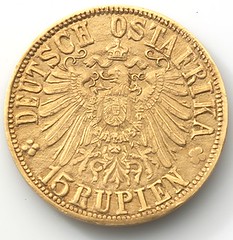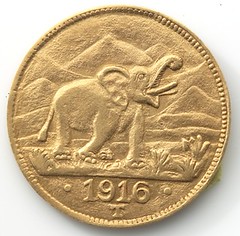
PREV ARTICLE
NEXT ARTICLE
FULL ISSUE
PREV FULL ISSUE
SWAHILI ON GERMAN EAST AFRICA BANKNOTES
Regarding Kerry Rodgers' question about the language seen on a German East Africa banknote, Pete Smith writes: My guess is Bantu-Swahili. I tried using a Swahili to English translator but couldn't figure out the whole phrase. It has something to do with the value of the note in German East Africa. Ron Guth writes: I believe the language on the back of the German East Africa notes was Swahili, which the Germans used as the official local language in addition to their own. David T. Alexander writes: The language on the Deutsch Ostafrika paper money is Swahili, a language initially developed by Arab slave traders and their African allies to facilitate communication among varied tribes. The Germans then went to work codifying this language, a task completed later under British rule in Uganda, Tanganyika (the erstwhile German East Africa) and Kenya. I had the honor of meeting one of the British fathers of modern Swahili 50 years ago as a graduate student in African Studies at the University of California at Los Angeles, the late Dr. Snoxall. A demand was heard decades ago in the U.S. by Black nationalists for the teaching of Swahili in American schools as an African language. Those making the demand were plainly ignorant of the massive slavery component in Swahili's birth! Regarding the military saga of "German East" and the numismatics of the colony before and during World War I, check out ANS Magazine for last Summer, where there was a definitive article by a fellow named Alexander! Chip Howell writes: The DOA (German East Africa) note looks to bear a Latinised Swahili message: I recognize "sahihi" is probably derived of the Arabic for real/genuine. Paul von Lettow-Vorbeck would be proud--he led their forces against the British in the Great War. There's a good account in "The Great War in Africa" by Byron Farwell. Andy Singer writes: I had time on my hands while watching the World Cup. My translation program identifies the language as Swahili. I thought it was going to be more complicated than that, although perhaps it is. Now, how do the 15 Rupees struck in Tabora relate to this note? Or Paul von Lettow, or Humphrey Bogart?
Thanks also to Howard Berlin, Larry Gaye, Ralf Böpple, Pablo Hoffman, and others. But by far my favorite response was from Jon Radel.
-Editor
Jon Radel writes: Jambo, Bwana Homren! When I lived in Kenya for 3 years as a child, I learned a very small amount of Swahili, most of which I've soundly forgotten. However, the vowel-heavy cadences, with considerably more recognizable loan words than the average language, still sound somewhat familiar. Between that and the fact that Swahili is effectively a "lingua franca" anywhere along the eastern coast of Africa, particular in areas within reach of sea trade coming south from Arabia, that has long served as a trade language and was heavily used by the colonial powers, and I was pretty sure of the answer. What I didn't realize until I just looked it up, was that the Germans made Swahili an official administrative language in Deutsch-Ostafrika in the late 19th century, unlike the British, who used it in British East Africa, but didn't accord it the same official position. Google Translate confirmed it. A useful note: If you're trying to pin down which language something is written in, so long as it's in one of the 75 or so most widely used languages, try using http://translate.google.com and pick "Detect language" as the source language. Kadri ya noti hii imewekwa sahihi katika Kaiserliches Gouvernement von Deutsch-Ostafrika. Of course, sometimes the Google translation is not all that it could be: As of this bill is installed right in Kaiserliches Gouvernement von Deutsch-Ostafrika. Alternate translations of "noti" include the English "note" or "banknote," and I wouldn't be the least bit surprised to find that coming from the British introduction of banknotes to the region.... Yosef Sa'ar adds: This is Swahili. If you feed the text into translate.google.com and use "Detect Language" you'll get it. What looks like Kalseritches on the note is apparently Kaiserlich (Imperial in German). Eric Schena adds: The coins and notes of Deutsch Ostafrika are really neat. And there's one coin that ties into the "Elephants on Coins" theme: the Tabora Mint 15 Rupien gold coin from 1916.


To read the complete ANS museum description, see: Gold 15 rupie, Tabora (Tanzania), 1888 - 1918 (numismatics.org/collection/1960.166.343)
To read the earlier E-Sylum articles, see:
The Numismatic Bibliomania Society is a non-profit organization promoting numismatic literature. See our web site at coinbooks.org. To submit items for publication in The E-Sylum, write to the Editor at this address: whomren@gmail.com To subscribe go to: https://my.binhost.com/lists/listinfo/esylum All Rights Reserved. NBS Home Page Contact the NBS webmaster 
|